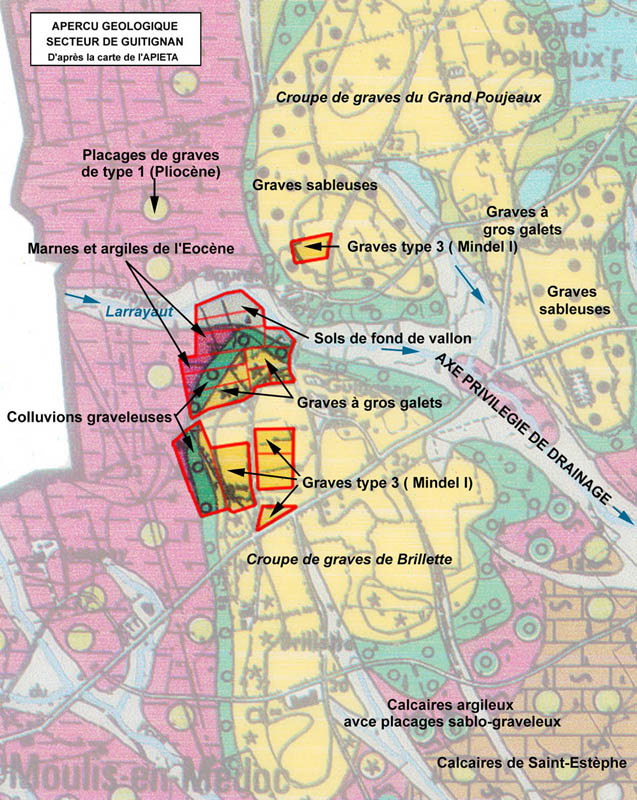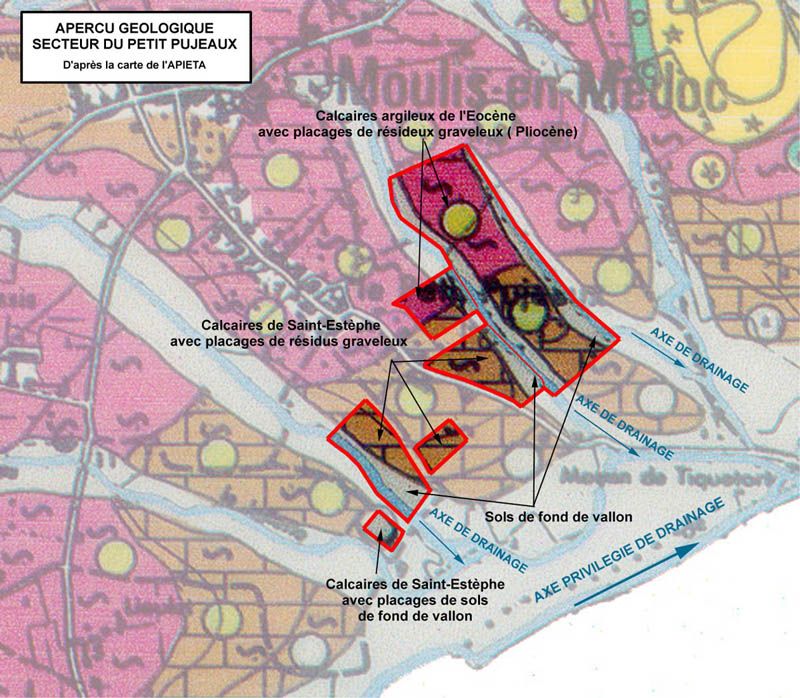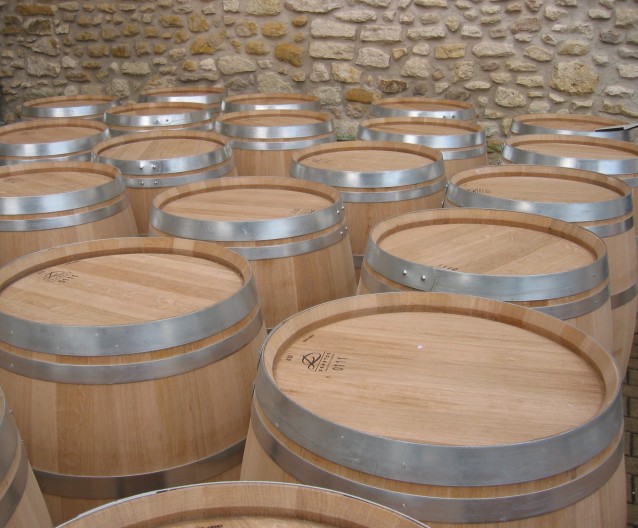Biston-Brillette, a typical Moulis terroir


The terroir of the Moulis appellation includes Pliocene gravel (type 1) near Bouqueyran, clayey-limestone soil from the Tertiary era near the market town, and middle-terrace glacial gravel (type 3) from Brillette to Maucaillou. With these diverse terroirs, the “signature” of the Château Biston-Brillette terroir lies in even balance between the gravel terroirs and the marl-clay-limestone terroirs surrounding the village of Moulis. The finesse and elegance of wines from gravel soils and the strength and colour of wines from clayey-limestone soils combine to offer Château Biston-Brillette a specificity much appreciated by wine-lovers.
Soils
The Guitignan gravel plots

The Guitignan plots of Château Biston Brillette belong to the gravel outcrops of Brillette, to the north-east of Moulis. These sites are located within the middle terrace of gravel constituted during the Mindel period ice break-up (approximately 600,000 to 400,000 years ago). This is referred to as Type 3 gravel by the Agriculture Association APIETA. The gravel dates back to Mindel I, contrary to type 3A, or 4, that corresponds to gravel deposited during the Mindel II ice break-up. The filtering nature of this gravel and of its sandy-gravelly colluvium is reinforced by water “respiration” ensured by the presence of ground-water trenches. Thanks to their outcrop relief created by erosion, these sedimentary formations rank among the soils most conducive to elite winemaking. This difference between the types of Garonne gravel would not be important if there had not been a speculative observation stating that all the terroirs of all the Grands Crus classified in 1855 are mainly planted in this type of Mindel glacial gravel. In Moulis, the Mindel I gravel reaches an altitude of 23 metres and is present only on the Brillette and Grand Poujeaux outcrops and on the slopes of Maucaillou.
The Eocene clayey-limestone soils of Petit Poujeaux

The sector of Petit Pujeaux, or Poujeaux, is marked by limestone from the Late Eocene epoch (38 to 34 million years), clayey-marl limestone and compact or less compact Saint-Estèphe limestone. The Eocene epoch spans from 53 to 34 million years ago and is divided into three periods. The oldest period, Early Eocene, is a generally cold period during which only sand was deposited. The intermediary period, Middle Eocene, with a warm and humid climate, was very fertile in massive limestone beds. The Late Eocene period was more temperate, marked by more clayey limestone and the presence of marl.
In the Petit Poujeaux area, the erosion caused by the Tiquetorte stream, a major ground-water trench, and its tributaries, dissected the limestone bedrock to form a hand shape. This soil configuration, that is typical of the clayey-limestone base of a gravel terrace, allows natural drainage and ensures good drying of the soil. The sites of the Château Biston-Brillette terroirs are located at the bottom of the ledge and the slope of the clayey-limestone terrace of Moulis, from 17 to 9 metres. These terroir sites are conducive to wines of strength and colour. Today, they are the ideal terroir for Merlot, Cabernet Franc and Petit Verdot, in warm regions. With fine wines from gravel soils, these clayey-limestone wines have always been very successful in the past, and still are today.
A specific microclimate

The Château Biston-Brillette terroir benefits from a microclimate that is rather favourable to the Merlot variety, that ripens early in these well-balanced sandy terroirs thanks to the presence of deeper clayey-limestone soils. The light and sandy Guitignan gravel, like the dry clay of Petit Poujeaux, causes water stress in summer, when the grapes ripen. This explains the concentration of Château Biston-Brillette wines, because the plant gives its very best when it does not receive water during the second half of the summer and the beginning of the autumn, although a summer storm between the middle and the end of July is beneficial because it lends the wine enhanced balance. These are the climatic features of a typical Bordeaux terroir, with a mild spring followed by water stress until the harvest.

Expression of the terroir
An astutely chosen expression for the terroir

The expression of a terroir such as that of Château Biston-Brillette depends on choices concerning grape varieties, work on the soil and in the vineyard, and vinification. Full mastery of the winemaking process is a prerequisite for quality. Although it is true that a great wine is rooted in the quality of the vineyard, the Biston-Brillette vat room, with its special-size stainless steel vats, allows vinification in keeping with the personality of the terroir sites, emphasising the typical features and expression of the wines.
From vineyard to cellar

First of all, the choice of expression of the terroir through the vine plant is based on precise soil analyses and on the experience of the winemaker, combined with a keen sense of observation. In rather cold locations, with clayey-limestone soil, the Merlot variety (60% of the estate) is ideal. Root stock 101-14 was chosen for these Merlot vines, given that their rather superficial root system allows them to benefit from the dryness of the clay in summer. As the main grape variety in Médoc gravel, Cabernet Sauvignon expresses the qualities of gravel soil, along with some Merlot. Riparia and 3309 root stocks are the best options in this case.
After parcellaire selection and stringent sorting on a table, the harvest is taken to a vat room, with 21 thermo-regulated stainless steel vats. To better respect the personality of plot wines, the vats are as high as they are wide. These rather unusual vat sizes provide excellent decanting, limit the thickness of the marc to 30 to 40% of the height, allow good vinification and make pumping-over easier. As in the past, crushing is required to reduce the thickness of the marc, to obtain more fruity aromas and smooth, elegant tannins. Vinification and barrel-ageing of the wine are constantly monitored by the Barbarin brothers, assisted by their consultant oenologist, Eric Boissenot.


The living terroir

The life of a terroir is based on balance between the culture of tradition and the requirements of modernity. At Château Biston-Brillette, human balance combines with that of the terroir, because it is provided by two brothers united by the same passion. These virtues would be lost if they were not shared directly with wine-lovers, at the estate, without the barrier of distribution. Fortunately, Biston-Brillette wine lovers want to be involved, to share the work of the winemaker, convey their impressions, tastes and choices, and express their likes. Direct sales require significant personal investment, but offer the satisfaction of conviviality. These fruitful exchanges offer interactive contacts that encourage the winemaker to surpass himself to craft a product of pleasure, an Epicurean dream.
The shared pleasure of Wine
Wine is part of the old world, but is also ideally suited to our modern lifestyle. Wine enhances shared sensations, ideas and pleasures. Each taster has his own impressions, but everyone agrees when a wine is appealing and rich in character. When a winemaker welcomes a wine-lover, whether the visitor is a discerning connoisseur or not, he is happy to share the secrets of his trade and his love of wine. Life in the country is free and quiet, but it beats to the pace of the seasons and the workload each new season brings. The winemaker is always an independent spirit, in a dialogue with nature from one vintage to the next. Although direct contact with private customers involves significant personal investment, Serge and Jean-Paul Barbarin have followed in the footsteps of their father, Michel, who decided in 1972 to sell his wine himself and open his château to all visitors. Since then, Château Biston-Brillette has always been a convivial location giving pride of place to great wine, where wine-lovers feel welcome in a spirit of total simplicity and authenticity.


